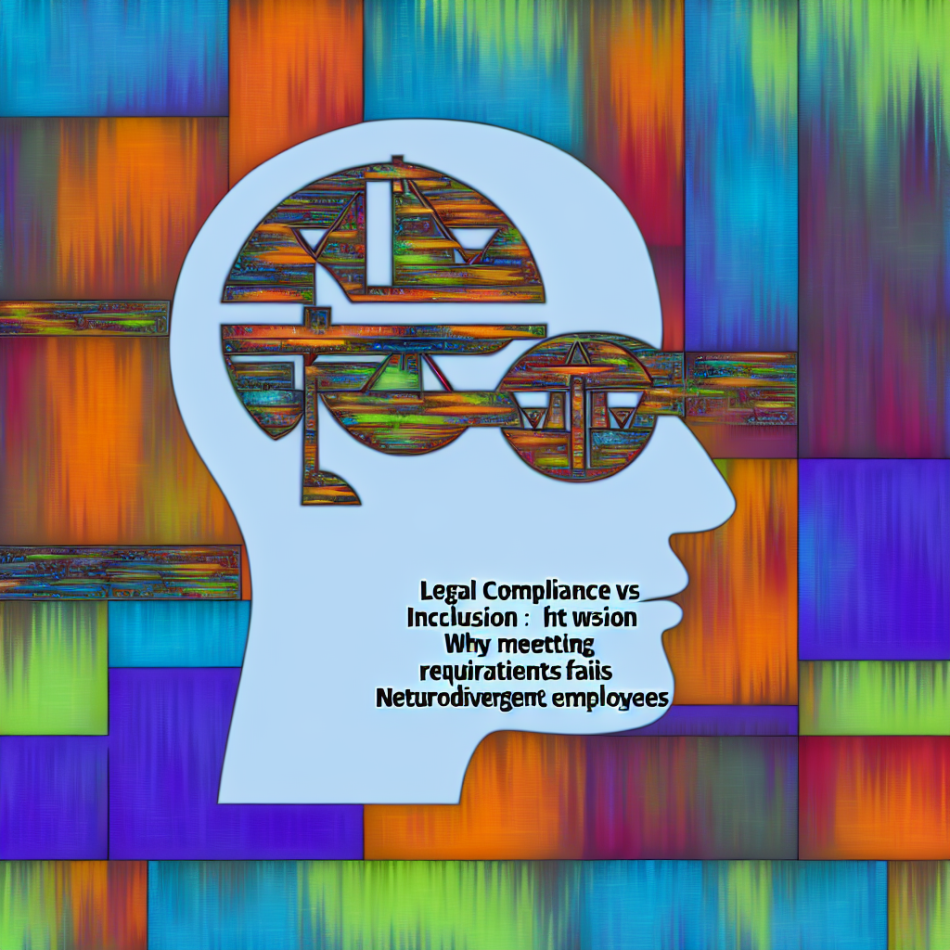Legal Compliance ≠ Inclusion: Why Meeting Requirements Isn’t Enough
Many organisations pride themselves on adhering to legal standards for workplace diversity, yet neurodivergent employees often remain undervalued and unsupported. Compliance with anti-discrimination laws is a baseline—not a finish line. True inclusion requires intentional cultural shifts that prioritise psychological safety, belonging, and individualised support. This article explores why ticking boxes fails neurodivergent talent and how companies can foster environments where everyone thrives.
Compliance vs. Inclusion: Understanding the Divide
Legal compliance focuses on meeting statutory obligations, such as providing reasonable adjustments under the Equality Act 2010. While vital, these measures are reactive and formulaic. Inclusion, however, demands proactive efforts to understand neurodivergent experiences—whether related to autism, ADHD, dyslexia, or other conditions—and address systemic barriers. A company might install wheelchair ramps to comply with accessibility laws, but fail to challenge stigma around neurodivergent communication styles. Inclusion isn’t about what’s legally required; it’s about what’s morally necessary.
The Limitations of a “Checkbox” Approach
Compliance-driven strategies often overlook the nuances of neurodiversity. For example, offering quiet rooms or flexible hours meets basic needs but doesn’t address deeper issues like:
- Microaggressions: Offhand comments (“You don’t look autistic!”) that invalidate neurodivergent identities.
- Rigid workflows: Inflexible deadlines or communication expectations that disadvantage those with processing differences.
- Lack of representation: Few neurodivergent leaders, perpetuating a cycle of exclusion.
Without addressing these cultural factors, compliance becomes a performative gesture, leaving neurodivergent employees feeling tokenised.
Psychological Safety: The Cornerstone of Inclusion
Neurodivergent individuals frequently mask their traits to fit into neurotypical norms—a survival tactic that erodes mental health. True inclusion hinges on psychological safety: environments where employees can disclose conditions without fear of judgement or career repercussions. This requires:
- Training managers to recognise and accommodate diverse communication styles.
- Encouraging open dialogues about neurodiversity, led by neurodivergent voices.
- Implementing feedback systems where employees can anonymously report exclusionary practices.
For instance, a neurodivergent employee might thrive with written instructions instead of verbal briefs—a simple adjustment that compliance alone wouldn’t mandate.
From Accommodation to Empowerment
Inclusive workplaces don’t just adapt to neurodivergent needs; they leverage their strengths. Many neurodivergent individuals excel in pattern recognition, innovation, or attention to detail—skills often stifled by traditional hierarchies. Companies like Microsoft and SAP have pioneered neurodiversity hiring programmes, pairing adjustments (e.g., sensory-friendly workspaces) with mentorship and career development. This shift from “fixing” employees to valuing their contributions fosters genuine belonging.
Leadership Accountability: Walking the Talk
Inclusion starts at the top. Leaders must:
- Audit policies through a neurodiversity lens (e.g., Are promotions tied to social skills over technical expertise?).
- Publicly champion neurodiversity initiatives, destigmatising disclosures.
- Allocate budgets for long-term training, not one-off workshops.
When leaders model vulnerability—sharing their own neurodivergence or advocating for systemic change—they signal that diversity isn’t a liability, but an asset.
Measuring What Matters: Beyond Retention Rates
Traditional metrics like employee retention or grievance reports are lagging indicators. Proactive companies track:
- Participation rates in neurodiversity networks.
- Employee sentiment surveys disaggregated by neurotype.
- Career progression of neurodivergent staff versus neurotypical peers.
These metrics reveal whether inclusion efforts are superficial or systemic. For example, high retention but low promotion rates for neurodivergent employees indicates a “glass ceiling” effect.
Conclusion: Building a Culture Where Compliance Is the Floor, Not the Ceiling
Legal compliance is essential, but it’s the bare minimum. Neurodivergent employees deserve workplaces that celebrate their uniqueness, amplify their voices, and nurture their potential. This requires moving beyond tick-box exercises to cultivate empathy, flexibility, and accountability at every level. Inclusion isn’t a policy—it’s a practice. By prioritising psychological safety and equitable opportunity, companies don’t just follow the law; they set a new standard for what it means to belong.
